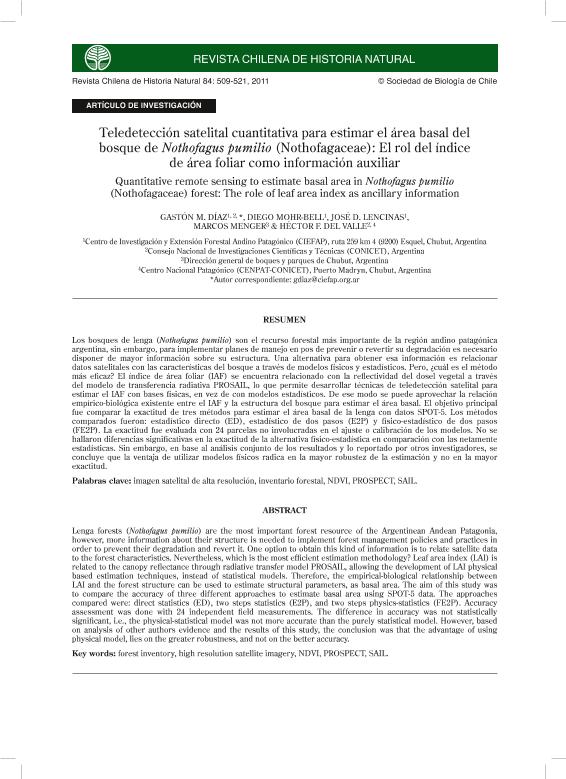Mostrar el registro sencillo del ítem
dc.contributor.author
Díaz, Gastón Mauro

dc.contributor.author
Mohr Bell, Diego
dc.contributor.author
Lencinas, José Daniel

dc.contributor.author
Menger, Marcos
dc.contributor.author
del Valle, Hector Francisco

dc.date.available
2019-08-28T19:18:30Z
dc.date.issued
2011-12
dc.identifier.citation
Díaz, Gastón Mauro; Mohr Bell, Diego; Lencinas, José Daniel; Menger, Marcos; del Valle, Hector Francisco; Teledetección satelital cuantitativa para estimar el área basal del bosque de Nothofagus pumilio (Nothofagaceae): El rol del índice de área foliar como información auxiliar; Sociedad de Biología de Chile; Revista Chilena de Historia Natural; 84; 4; 12-2011; 509-521
dc.identifier.issn
0716-078X
dc.identifier.uri
http://hdl.handle.net/11336/82418
dc.description.abstract
Los bosques de lenga (Nothofagus pumilio) son el recurso forestal más importante de la región andino patagónica argentina, sin embargo, para implementar planes de manejo en pos de prevenir o revertir su degradación es necesario disponer de mayor información sobre su estructura. Una alternativa para obtener esa información es relacionar datos satelitales con las características del bosque a través de modelos físicos y estadísticos. Pero, ¿cuál es el método más efi caz? El índice de área foliar (IAF) se encuentra relacionado con la refl ectividad del dosel vegetal a través del modelo de transferencia radiativa PROSAIL, lo que permite desarrollar técnicas de teledetección satelital para estimar el IAF con bases físicas, en vez de con modelos estadísticos. De ese modo se puede aprovechar la relación empírico-biológica existente entre el IAF y la estructura del bosque para estimar el área basal. El objetivo principal fue comparar la exactitud de tres métodos para estimar el área basal de la lenga con datos SPOT-5. Los métodos comparados fueron: estadístico directo (ED), estadístico de dos pasos (E2P) y físico-estadístico de dos pasos (FE2P). La exactitud fue evaluada con 24 parcelas no involucradas en el ajuste o calibración de los modelos. No se hallaron diferencias signifi cativas en la exactitud de la alternativa físico-estadística en comparación con las netamente estadísticas. Sin embargo, en base al análisis conjunto de los resultados y lo reportado por otros investigadores, se concluye que la ventaja de utilizar modelos físicos radica en la mayor robustez de la estimación y no en la mayor exactitud.
dc.description.abstract
Lenga forests (Nothofagus pumilio) are the most important forest resource of the Argentinean Andean Patagonia, however, more information about their structure is needed to implement forest management policies and practices in order to prevent their degradation and revert it. One option to obtain this kind of information is to relate satellite data to the forest characteristics. Nevertheless, which is the most effi cient estimation methodology? Leaf area index (LAI) is related to the canopy refl ectance through radiative transfer model PROSAIL, allowing the development of LAI physical based estimation techniques, instead of statistical models. Therefore, the empirical-biological relationship between LAI and the forest structure can be used to estimate structural parameters, as basal area. The aim of this study was to compare the accuracy of three different approaches to estimate basal area using SPOT-5 data. The approaches compared were: direct statistics (ED), two steps statistics (E2P), and two steps physics-statistics (FE2P). Accuracy assessment was done with 24 independent fi eld measurements. The difference in accuracy was not statistically signifi cant, i.e., the physical-statistical model was not more accurate than the purely statistical model. However, based on analysis of other authors evidence and the results of this study, the conclusion was that the advantage of using physical model, lies on the greater robustness, and not on the better accuracy.
dc.format
application/pdf
dc.language.iso
spa
dc.publisher
Sociedad de Biología de Chile

dc.rights
info:eu-repo/semantics/openAccess
dc.rights.uri
https://creativecommons.org/licenses/by-nc-sa/2.5/ar/
dc.subject
Imagen Satelital de Alta Resolución
dc.subject
Inventario Forestal
dc.subject
Ndvi
dc.subject
Prospect
dc.subject
Sail
dc.title
Teledetección satelital cuantitativa para estimar el área basal del bosque de Nothofagus pumilio (Nothofagaceae): El rol del índice de área foliar como información auxiliar
dc.title
Quantitative remote sensing to estimate basal area in Nothofagus pumilio (Nothofagaceae) forest: The role of leaf area index as ancillary information
dc.type
info:eu-repo/semantics/article
dc.type
info:ar-repo/semantics/artículo
dc.type
info:eu-repo/semantics/publishedVersion
dc.date.updated
2019-07-15T19:58:49Z
dc.identifier.eissn
0717-6317
dc.journal.volume
84
dc.journal.number
4
dc.journal.pagination
509-521
dc.journal.pais
Chile

dc.journal.ciudad
Santiago de Chile
dc.description.fil
Fil: Díaz, Gastón Mauro. Centro de Investigación y Extensión Forestal Andino Patagónico; Argentina. Consejo Nacional de Investigaciones Científicas y Técnicas; Argentina
dc.description.fil
Fil: Mohr Bell, Diego. Centro de Investigación y Extensión Forestal Andino Patagónico; Argentina
dc.description.fil
Fil: Lencinas, José Daniel. Centro de Investigación y Extensión Forestal Andino Patagónico; Argentina. Consejo Nacional de Investigaciones Científicas y Técnicas; Argentina
dc.description.fil
Fil: Menger, Marcos. Consejo Nacional de Investigaciones Científicas y Técnicas. Centro Científico Tecnológico Conicet - Centro Nacional Patagónico; Argentina
dc.description.fil
Fil: del Valle, Hector Francisco. Consejo Nacional de Investigaciones Científicas y Técnicas. Centro Científico Tecnológico Conicet - Centro Nacional Patagónico; Argentina
dc.journal.title
Revista Chilena de Historia Natural

dc.relation.alternativeid
info:eu-repo/semantics/altIdentifier/url/http://rchn.biologiachile.cl/es/contents/2011v84n4.php
dc.relation.alternativeid
info:eu-repo/semantics/altIdentifier/doi/http://dx.doi.org/10.4067/S0716-078X2011000400004
dc.relation.alternativeid
info:eu-repo/semantics/altIdentifier/url/https://scielo.conicyt.cl/scielo.php?script=sci_arttext&pid=S0716-078X2011000400004&lng=es&nrm=iso&tlng=es
Archivos asociados
